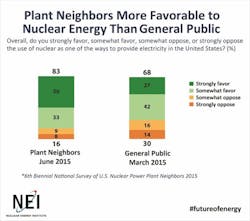Nuclear Gets a Nod in Clean Power Plan, but No Love in the Press
As promised in my previous post ‘Get Ready for Clean Energy from New Nuclear’ – the Clean Power Plan was announced today. If you don’t want to read the detailed plan then I suggest reading this very informative overview.
In the plan, Nuclear technology gets a positive nod for being a ‘zero-carbon source.’
“The Clean Power Plan will no longer count nuclear plants under construction in state targets, but it will give states credit for them and for increases in existing nuclear generation…”
and, “The final plan gives the nuclear power industry two of the changes it pressed hard for, one of them affecting the treatment of the five nuclear units currently under construction in Georgia, South Carolina and Tennessee. Their output now won’t be counted until the plants are actually operating, which eases those states’ compliance challenges. Increased nuclear power production from “uprates,” or capacity increases at existing plants, will also count as zero-carbon sources in meeting state requirements, making such projects more valuable.” _ covered by Scientific American.
Despite the fact that nuclear is carbon-free, renewables were the star of every press release and article I’ve spotted covering the Clean Power Plan. Front and center, most articles stated that the energy that was once produced from coal-burning power plants will now come from renewable energy technologies. It was also very clear that energy would not switch from coal-burning plants to natural gas options.
I don’t have anything against wind and solar, but can’t nuclear get a little love? Here’s three pieces of information that made me believe in nuclear technologies:
- Anti-Nuclear activists switch sides. Watch the documentary Pandora’s Promise, available on Netflix, too. This documentary interviews all the popular anti-nuclear activists and shows them openly admitting they were ‘wrong’ about nuclear and that they approve it. One eye-opening point covered is that for the past two decades, 10% of all the electricity consumed in the United States has come from Russian nuclear warheads.
- Education about nuclear will enter the classrooms. Washington State Senator Sharon Brown has included clean-energy education into the recently passed bill for Small Modular Reactors for students. And clean-energy includes nuclear.
“Added to the bill is a requirement that the state Department of Commerce and the Office of the Superintendent of Public Instruction prepare a joint report to the Legislature by Dec. 1 with recommendations for a clean-energy education program.
The program would be required to include grants both for clean-energy ambassadors and for professional development for teachers.
The clean-energy ambassadors would visit classrooms to introduce students to clean energy science and technology. They could cover solar and wind power, small modular reactors and opportunities for nuclear waste cleanup technology careers.
Certified science teachers could receive grants to help them pursue professional development opportunities in clean-energy science and broaden their exposure to the field.
One way to ensure that young people understand nuclear energy is to introduce them to our many great scientists, engineers and others who work in the nuclear field,” Brown said. “It’s also one of the best ways to guarantee that the next-generation of Washington job-seekers is prepared for opportunities in emerging nuclear and other clean-energy fields.”
- The majority of the general public and even neighbors of nuclear plants are on board. Recent research conducted by Bisconti Research, Inc. and Quest Global Research show that the majority of the general public and even neighbors to nuclear plants are pro-nuclear. The poll found that of the general public, 86% percent agreed with the statement, "we should renew the license of nuclear power plants that continue to meet federal safety standards.” 77% agree that companies should prepare now so that new nuclear power could be built in the next decade. And, 83% percent of respondents believe it is important for the U.S. nuclear industry to play a leading role in world markets.
Nuclear power plant neighbors’ attitudes toward nuclear energy are more favorable than those of the general U.S. public: 83% of plant neighbors favor the use of nuclear energy, compared with 68% of the general public surveyed this February. Compared with the general public, twice as many plant neighbors strongly favor nuclear energy—50% compared with 27%.
While the world is racing to cut carbon emissions, let’s not forget nuclear is a strong technology to couple with renewables. However, new nuclear designs and technologies like Small Modular Reactors and Molten Salt Reactors are going to take time. There are still many hurdles like financing, regulations, and commercialization of the designs. Not to mention, despite the statistics from NEI, that nuclear still has a bad stigma. So, I want to hear from you…how would you solve these issues?
Lindsey Frick @BigIdeaEngineer
About the Author
Lindsey Frick Blog
Associate Editor
Lindsey serves a Associate Editor for Machine Design since 2012. She holds a Bachelor of Science in mechanical engineering from Cleveland State University. Prior to joining Penton, she has worked in product design, packaging, development, strategy, and manufacturing. She covers the materials market and other areas of interest for design engineers.

